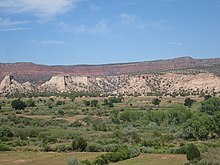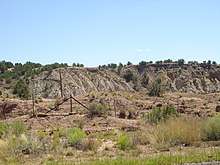Zia Formation
The Zia Formation is a geologic formation in the southwestern Jemez Mountains and northwestern Santo Domingo Basin. It contains vertebrate fossils that date it to early to middle Miocene in age.
| Zia Formation Stratigraphic range: Miocene | |
|---|---|
 Zia Formation badlands northwest of Jemez Pueblo | |
| Type | Formation |
| Unit of | Santa Fe Group |
| Underlies | Arroyo Ojito Formation, Cochiti Formation |
| Overlies | Galisteo Formation |
| Thickness | 300 m (980 ft) |
| Lithology | |
| Primary | Sandstone |
| Location | |
| Coordinates | 35.5241523°N 106.748613°W |
| Region | New Mexico |
| Country | United States |
| Type section | |
| Named for | Zia Pueblo, New Mexico |
| Named by | Regan |
| Year defined | 1903 |
 Zia Formation (the United States)  Zia Formation (New Mexico) | |
Description

Lithologically, the Zia Formation is a very soft quartz sandstone. The type section rests on about 10m of laminated greenish clay beds that in turn rest on the Galisteo Formation. The upper contact is with the Arroyo Ojito Formation, with the Cochiti Formation, or with Miocene volcanic rocks of the Jemez volcanic field.[1] [2]
The formation is divided (in ascending stratigraphic order) into the Piedra Parada Member, the Chamisa Mesa Member. the Canada Pilares Member.[3], and the Cerro Conejo Member. The basalt of Chamisa Mesa, with a radiometric age of 10.4 Ma, is interbedded with the Cerro Conejo Member.[4]
The formation is interpreted as eolian deposits derived from volcaniclastics of the Jemez volcanic field. These were first transported south by the Jemez River, then transported by wind from the west.[4]
Fossils
The Cerro Conejo Member includes the Rincon quarry and Zia prospect, which yield fossils of Barstovian age, about 11 to 14 Ma.[5]
History of investigation
The formation was first described by Regan in 1903, who named it the Zia Marl. T. Galusha renamed it the Zia Sand Formation and divided it into the lower Piedra Parada Member and the upper Chamisa Mesa Member. He also recognized a subtle disconformity about 120 m above its base.
Footnotes
- Galusha (1966)
- Manley (1978)
- Gawne (1981)
- Connell et al. (1999)
- Connell et al. 1999, p.346
References
- Connell, S.D.; Koning, D.J.; Cather, S.M. (1999). "Revisions to the stratigraphic nomenclature of the Santa Fe Group, northwestern Albuquerque basin, New Mexico" (PDF). New Mexico Geological Society Field Conference Guidebook. 50: 337–354. Retrieved 10 June 2020.
- Galusha, T. (1966). "The Zia Sand Formation, new early to medial Miocene beds in New Mexico". American Museum Novitates. 2271.
- Gawne, C.E. (1981). "Sedimentology and stratigraphy of the Miocene Zia Sand of New Mexico". Geologic Society of American Bulletins. 92 (12): 999.
- Manley, Kim (1978). "Geologic map of the Bernalillo NW quadrangle, Sandoval County, New Mexico". National Geologic Map Database. U.S. Geological Survey. Retrieved 21 March 2020.